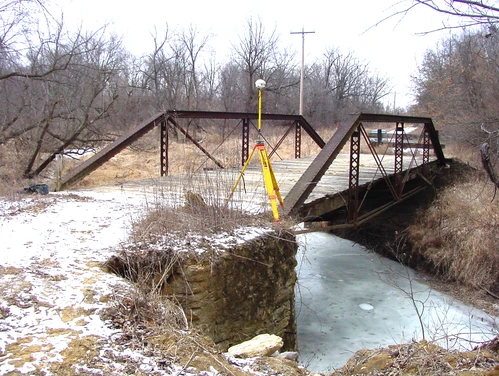- Year constructed: 1893
- Alternate name: Gripple's Quarry Bridge, Buffington Creek Bridge
- Bridge type: Pin-Connected Pratt Pony Truss
- National Register of Historic Places status: Listed
- Length: 78 feet
- Width: 15.7 feet
- Spans: 1
- FHWA: 224310
- Jurisdiction: Louisa County
- Location: V Avenue over Buffington Creek, 5.8 miles southwest of Columbus Junction, Section 22 & 23, T74N-R5W (Elm Grove Township)
Details
In 1879, the Louisa County Board of Supervisors granted a petition by Thomas Stronach and other local residents to change the location of a county road in Elm Grove Township southwest of Columbus Junction. The changed alignment carried the road over Buffington Creek, necessitating the construction of a new bridge in the summer of 1881. With its timber pile construction, the structure was predictably short-lived. Eleven years after its completion, nearby stone quarry owner T.J. Gipple petitioned the county for a new, more substantial bridge at this crossing. In April 1893 the board of supervisors opened bidding for a new iron bridge. A contract to supply the truss superstructure for this crossing--and for the County Line Bridge over Long Creek in Columbus Township-- was awarded to the Gillette-Herzog Manufacturing Company of Minneapolis, Minnesota. (Cost: $1,174 for the two spans.) Using steel components rolled in Pittsburgh by Carnegie, Gillette-Herzog fabricated the medium-span pony trusses and erected them by September 1893. Both spans have since carried county-road traffic in essentially unaltered condition.
With its pin-connected detailing and Pratt design, the pony truss on the Gipple's Quarry Bridge typifies iron bridge construction in Iowa from the early 1890s. What distinguishes this structure from most of its peers is its unusual lower chord configuration, with the end panels sloped downward from the bearing shoes to the center panels. Only a handful of spans employing this Pratt truss variation has been identified by the historic bridge inventory. The Gipple's Quarry Bridge is thus technologically significant as a well-preserved, early, unusually designed example of wagon bridge construction in Iowa.
Adapted from Fraser 1991
Areas Served
- Louisa
